Why Balanced Funds may be the best investments for new mutual fund investors

Balanced funds have been around in India for more than 20 years. Balanced funds enable the investors to get exposure to equities and consequently earn excellent long term returns with significantly lower levels of risks compared to equity funds. The merits of these funds notwithstanding, for a long time balanced funds lagged behind equity funds in popularity stakes. Lack of investor awareness was probably to blame for this. However, in the recent past balanced funds have been gaining a lot of traction with investors. In fact, as per AMFI, in 2015, Assets under Management (AUM) of balanced funds were up 70% compared to the year before. At the same time, as per AMFI, mutual funds closed 2015 with the highest ever folio count of 4.6 crores, nearly 14% year on year growth, which means that a lot of new investors started investing in mutual funds in 2015. If we combine these two important developments, the implication is that lot of new investors may have selected balanced funds for their mutual fund investments. This is indeed a very good development, and an evidence of growing maturity of the mutual fund industry, the financial advisor community and more importantly the investors in India. Balanced funds may be one of the best, if not the best, investment options for new investors. We will discuss, why, in our blog post today.
What are Balanced Funds?
Balanced Funds are hybrid equity oriented mutual fund schemes. These funds usually invest 65 – 75% of their portfolio in equity securities and the remaining portion in debt or money market securities. The hybrid portfolio moderates the fund volatility to a certain degree while enabling potential wealth creation in the long term. Since at least 65% of the portfolio is invested in equity or equity related securities, balanced funds are subject to equity taxation. Long term capital gains, for investment period of more than 1 year, is tax exempt. Short term capital gains, for investment periods of less than 1 year, is taxed at 15%. Dividends from balanced fund schemes are also tax free.
Why are they ideal for new investors?
We have discussed a number of times in our blog that, equity as an asset class outperforms other asset classes in the long term. As such equity is the best asset class to invest in for your long term financial goals, like retirement planning. While equities give the highest returns in long term, the fact remains that equities are highly volatile assets in the short term, which means that you can make losses in the short term. Volatility is, psychologically, very stressful for retail investors. We have seen that, many retail investors start their investments in equity mutual funds lured by high returns, usually at the peak of bull markets. Bear markets inevitably follow bull markets, and when these investors make big losses they redeem their investments and turn away from mutual funds, harming their own financial goals in the long term.
Balanced fund are less volatile than equity funds and therefore these funds make less losses in market corrections. For example, in 2008 diversified equity funds made on an average 54% loss, whereas balanced funds made 32% loss. Similarly, in 2011 diversified equity funds made on average 25% loss while balanced funds made 13% loss. Some readers may argue, so what? Equity funds make more profit in bull markets. That is correct. In 2007 diversified equity funds made a profit of 61% whereas balanced funds made a profit of 35%. Therefore, the higher profits made by diversified equity funds in 2007 more than compensated the higher losses made by diversified equity funds in 2008 compared to balanced funds. Does it not then, make a case for diversified equity funds? The answer is both yes and no. There are both behavioural and financial aspects to this argument. Let us discuss the behavioural aspect first.
If you are not affected by volatility and losses thereof, and you have a long investment horizon, equity funds are better for you. Ultimately, over a long investment horizon you will create more wealth with equity funds compared to balanced funds. But in reality, for most retail investors, losses have a bigger psychological impact than profits. This in behavioural finance parlance is known as negativity bias. If you are making profits, you may or may not invest more money in equity funds, but if you are making losses, there is greater likelihood of stopping and even redeeming your investments.
Let us now come to financial aspect. We will spend the rest of this post, discussing the financial aspect. The most fundamental concept of investment is the risk return trade-off. If you take more risk, you are likely to get higher returns. If you take less risk, you will get lower returns. Therefore, if you are very clear about your own investment objectives, including but not limited to your investment horizon and how much risk you need to take to meet your investment objectives, you will be able to select the most suitable investment scheme, be it an equity fund, balanced fund or income fund. There are large number of schemes in the market, each with their own risk return profiles. An analytical understanding of the risk return linkage, over and above the fact that more risk means more returns, is difficult for even experienced and informed investors to grasp, not to mention new investors. For new investors, risk adjusted returns should, therefore, be an important consideration, especially if you are unclear about how much risk to take to meet your long term financial goals.
What are risk-adjusted returns?
Risk adjusted return is the return you get for a given amount of risk. Let us illustrate with the help of a simplistic example. Suppose a mutual fund scheme “A” can give you 20% returns. But there is a 30% probability of making losses. Another mutual fund scheme “B” can give you 15% returns with a 10% probability of making losses. Which fund will you go for? If you are willing to accept a 30% probability of making losses, then you will go for fund “A”. But if you are unclear, the amount of loss you are willing to accept, then by selecting fund “B”, even though you get 5% less returns than fund “A”, you cut down the probability of making a loss by 20%. This, in very simplistic terms, is the essence of risk adjusted returns. The financial measure of risk adjusted returns is a bit more complicated and is known as Sharpe Ratio. Sharpe ratio is defined as the ratio of excess return (i.e. difference of return of the fund and risk free return from Government securities) and annualized standard deviation of returns (a measure of volatility risk of a fund). Higher the Sharpe ratio better is the risk adjusted performance of the fund.
Balanced Funds give better risk adjusted returns than other equity fund categories
In our blog, we always strive to be as data oriented and analytical as possible in our observations. Many mutual fund investment experts say that, balanced funds give better risk adjusted returns than equity funds. Is there an analytical foundation to this statement? Yes there is and this is what we will discuss in the rest of this post. We will look at the risks and returns of different equity fund categories and balanced funds with actual historical data to examine the risk adjusted returns of these different categories of mutual funds. Sharpe ratio as a concept is easy enough to understand, but the numerical values of Sharpe ratio is not so easy to grasp from a risk return perspective. We will look at actual returns and the risks.
How do different equity fund categories compare in terms of risk and return
The chart below shows the comparison of average annual returns of large cap and small/midcap funds categories over the last 10 years, from 2006 to 2015.
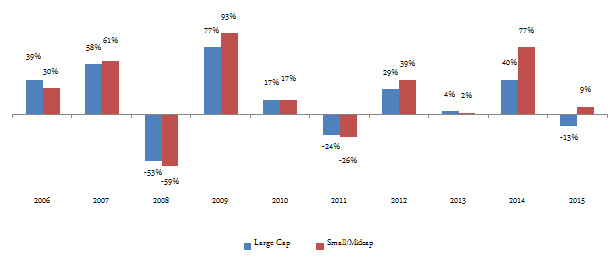
Source: Morningstar
We can see that, with 2006 and 2015 being exceptional years, small and midcap funds outperformed large cap funds in bull markets and underperformed in bear market. This is consistent with the risk return characteristics of these two categories of equity funds. Let us now see the difference in average annual returns between the small/midcap funds and large cap over the last 10 years.

The average difference in annual returns of small/midcap funds and large cap funds was 7%. The outperformance of small and midcap funds versus large cap funds was only to be expected, because the small and midcap funds are more risky compared to large cap funds. But remember, we are concerned with risk adjusted returns. So how much risk did small and midcap funds take versus large cap funds? Volatility or standard deviation of returns is the most common measure of risk. The volatility (or annualized standard deviation of returns) of small and midcap funds over the last 10 years was 29%, whereas that of large cap funds was 24%. Therefore the difference in volatility, or in other words risk, between these two fund categories is about 5%. You will recall that the difference in returns between small/midcap and large cap funds is about 7%. You can see that the difference in risk (volatility) and returns are similar, with small/midcap funds giving slightly better risk adjusted returns compared to large cap funds.
Let us now see the comparison of average annual returns of large cap and diversified equity funds categories over the last 10 years, from 2006 to 2015. You may recall that diversified equity funds invest in both large cap and small/midcap stocks. Therefore, their risk return profile is to be somewhere between large cap and small/midcap funds.
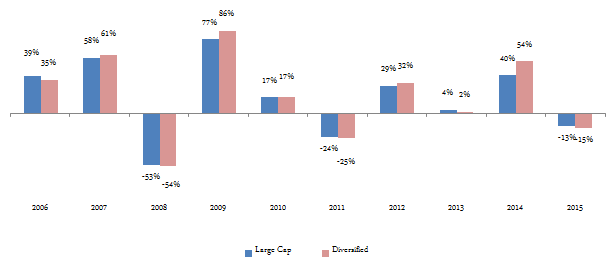
Source: Morningstar
We can see that, with 2006 being an exceptional year, diversified equity funds outperformed large cap funds in bull markets and underperformed in bear markets. This is consistent with the risk return characteristics of these two categories of equity funds. Let us now see the difference in average annual returns between the diversified equity funds and large cap over the last 10 years.
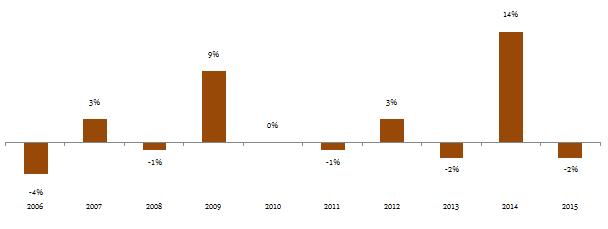
The average difference in annual returns of diversified equity and large cap funds was 2%.You can see that the differences between diversified equity funds and large cap annual returns are lower than the differences between small/midcap and large cap equity funds, as expected. How much risk did diversified equity funds take versus large cap funds? The volatility of diversified equity funds over the last 10 years was 25%, whereas that of large cap funds was 24%. Therefore the difference in risk, between these two fund categories is about 1%. You can see that the difference in risk (volatility) and returns are almost the same. Therefore, the risk adjusted returns of large cap and diversified equity funds are almost the same.
Let us now see if balanced funds gave better risk adjusted returns compared to large cap, diversified equity and small/midcap funds. The chart below shows the comparison of average annual returns of large cap and balanced fund categories over the last 10 years, from 2006 to 2015.
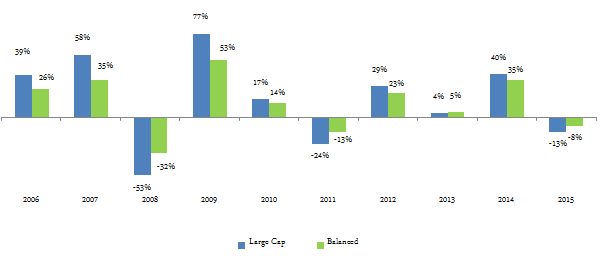
Source: Morningstar
We can see that, as expected, balanced funds underperformed large cap funds in bull markets and outperformed in bear markets. Let us now see the difference in average returns between the balanced and large cap funds over the last 10 years.

The average difference in annual returns of balanced funds and large cap was -4%. Therefore large cap funds outperformed balanced funds by 4%. But how much risk did large cap funds take versus balanced funds? The volatility of large cap funds over the last 10 years was 24%, whereas that of balanced funds was only 11%. Therefore, while large cap funds took 13% more risk than balanced funds, the difference in return was only 4%. It is evident that balanced funds gave better risk adjusted returns than large cap funds. Compare the differences of return and risk of balanced funds versus large cap funds, with the differences of return and risk of diversified equity versus large cap funds and small/midcap versus large cap funds respectively. It will be clear that, balanced funds outperformed large cap, diversified equity and small/midcap funds. Please note we have compared the risk and return of these different fund categories using a fairly simple analysis, so that the average (not so finance savvy) readers can grasp the concept of risk adjusted returns. Even if we use a more sophisticated an accurate measure of risk adjusted returns like the Sharpe Ratio, the results are fairly consistent, with our findings above.
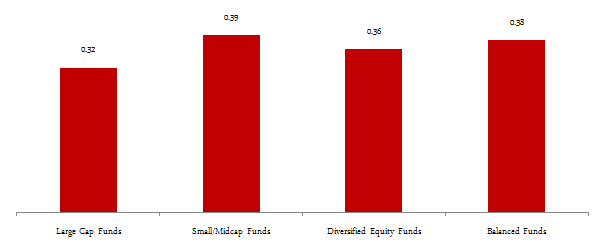
Source: Morningstar
Conclusion
Why balanced funds were able to give higher risk adjusted returns? Because balanced funds keep rebalancing their asset allocation to maintain their asset allocation (equity and debt) ratios within a certain range. They shift from equity to debt when equity valuations are high and from debt to equity when equity valuations are low. In this blog post, we have discussed why balanced funds are one of the best investment options for new investors. They are equally good investment options for even experienced investors who can use these funds for managing their asset allocation between equity and debt. The equity taxation of balanced funds also makes it attractive for investors. Investors should consult with financial advisors, if balanced funds are suitable for their investment portfolio.
Disclaimer:
Any information contained in this article is only for informational purpose and does not constitute advice or offer to sell/purchase units of the schemes of SBI Mutual Fund. Information and content developed in this article has been provided by Advisorkhoj.com and is to be read from an investment awareness and education perspective only. SBI Mutual Fund’s participation in this article is as an advertiser only and the views / content expressed herein do not constitute the opinions of SBI Mutual Fund or recommendation of any course of action to be followed by the reader
RECOMMENDED READS
- Demystifying debt mutual funds
- How do you know if you have good funds in your mutual funds portfolio: part 1
- Know your mutual fund tax obligations to manage your investments effectively
- Asset Allocation is much more important than fund selection
- How do you know if you have good funds in your mutual funds portfolio: part 2
LATEST ARTICLES
- SBI Multi Asset Allocation Fund: Power of Multi Asset Allocation in Volatile Markets
- SBI Multi Asset Allocation Fund: Power of multi asset allocation in volatile market
- SBI Multicap Fund: Off to a great start
- SBI Balanced Advantage Fund: Benefits of growth and stability
- SBI Conservative Hybrid Fund: A suitable fund for first time investors with stellar track record of consistent outperformance
Quick Links
Follow SBI MF
More About SBI MF
POST A QUERY




